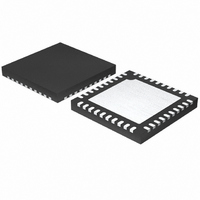MAX1544ETL+ Maxim Integrated Products, MAX1544ETL+ Datasheet - Page 27

MAX1544ETL+
Manufacturer Part Number
MAX1544ETL+
Description
IC QUICK-PWM DUAL-PHASE 40-TQFN
Manufacturer
Maxim Integrated Products
Series
Quick-PWM™r
Datasheet
1.MAX1544ETLT.pdf
(42 pages)
Specifications of MAX1544ETL+
Applications
Controller, AMD Hammer
Voltage - Input
2 ~ 28 V
Number Of Outputs
1
Voltage - Output
0.68 ~ 1.55 V
Operating Temperature
-40°C ~ 100°C
Mounting Type
Surface Mount
Package / Case
40-TQFN Exposed Pad
Output Voltage
0.675 V to 1.55 V
Output Current
40 A
Input Voltage
4 V to 28 V
Mounting Style
SMD/SMT
Maximum Operating Temperature
+ 100 C
Minimum Operating Temperature
- 40 C
Lead Free Status / RoHS Status
Lead free / RoHS Compliant
The multiphase Quick-PWM controller integrates the
difference between the current-sense voltages and
adjusts the on-time of the secondary phase to maintain
current balance. The current balance now relies on the
accuracy of the current-sense resistors instead of the
inaccurate, thermally sensitive on-resistance of the low-
side MOSFETs.
With active current balancing, the current mismatch is
determined by the current-sense resistor values and the
offset voltage of the transconductance amplifiers:
where V
tion in the Electrical Characteristics.
The worst-case current mismatch occurs immediately
after a load transient due to inductor value mismatches
resulting in different di/dt for the two phases. The time it
takes the current-balance loop to correct the transient
imbalance depends on the mismatch between the
inductor values and switching frequency.
The multiphase Quick-PWM controllers include an inde-
pendent operational amplifier for adding gain to the volt-
age-positioning sense path. The voltage-positioning
gain allows the use of low-value current-sense resistors
in order to minimize power dissipation. This 3MHz gain-
bandwidth amplifier was designed with low offset volt-
age (70µV typ) to meet the IMVP output accuracy
requirements.
The inverting (OAIN-) and noninverting (OAIN+) inputs
are used to differentially sense the voltage across the
voltage-positioning sense resistor. The op amp’s output is
internally connected to the regulator’s feedback input
(FB). The op amp should be configured as a noninvert-
ing, differential amplifier, as shown in Figure 10. The
voltage-positioning slope is set by properly selecting the
feedback resistor connected from FB to OAIN- (see the
Setting Voltage Positioning section). For applications
using a slave controller, additional differential input
resistors (summing configuration) can be connected to
the slave’s voltage-positioning sense resistor. Summing
together both the master and slave current-sense signals
ensures that the voltage-positioning slope remains con-
stant when the slave controller is disabled.
OS(IBAL)
I
OS IBAL
(
Feedback Adjustment Amplifiers
)
is the current balance offset specifica-
=
______________________________________________________________________________________
AMD Hammer CPU Core Power Supplies
I
LM
Voltage-Positioning Amplifier
Dual-Phase, Quick-PWM Controller for
-
I
LS
=
V
R
OS IBAL
SENSE
(
)
The controller also uses the amplifier for remote output
sensing (FBS) by summing in the remote-sense voltage
into the positive terminal of the voltage-positioning
amplifier (Figure 10).
In applications that do not require voltage-positioning
gain, the amplifier can be disabled by connecting the
OAIN- pin directly to V
put becomes a high impedance, guaranteeing that the
unused amplifier does not corrupt the FB input signal.
The logic threshold to disable the op amp is approxi-
mately V
A feedback amplifier forces the DC average of the
feedback voltage to equal the VID DAC setting. This
transconductance amplifier integrates the feedback
voltage and provides a fine adjustment to the regulation
voltage (Figure 5), allowing accurate DC output voltage
regulation regardless of the output ripple voltage. The
feedback amplifier has the ability to shift the output
voltage. The differential input voltage range is at least
±80mV total, including DC offset and AC ripple. The
integration time constant can be set easily with an
external compensation capacitor at the CCV pin. Use a
capacitor value of 47pF to 1000pF (47pF typ).
The multiphase Quick-PWM controllers include differen-
tial remote-sense inputs to eliminate the effects of volt-
age drops down the PC board traces and through the
processor’s power pins. The remote output sense (FBS)
is accomplished by summing in the remote-sense volt-
age into the positive terminal of the voltage-positioning
amplifier (Figure 10). The controller includes a dedicat-
ed input and internal amplifier for the remote ground
sense. The GNDS amplifier adds an offset directly to
the feedback voltage, adjusting the output voltage to
counteract the voltage drop in the ground path.
Together, the feedback sense resistor (R
GNDS input sum the remote-sense voltages with the
feedback signals that set the voltage-positioned output,
enabling true differential remote sense of the processor
voltage. Connect the feedback sense resistor (R
and ground sense input (GNDS) directly to the proces-
sor’s core supply remote-sense outputs as shown in the
Standard Applications Circuit.
CC
- 1V.
CC
. The disabled amplifier’s out-
Differential Remote Sense
Integrator Amplifier
FBS
) and
FBS
27
)











